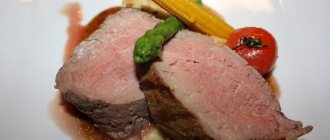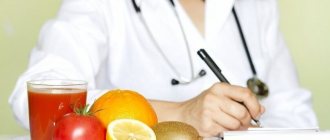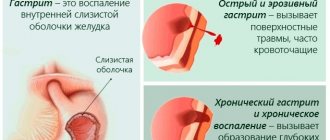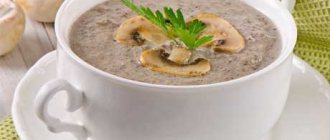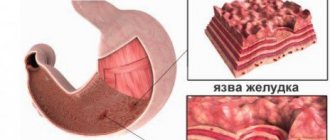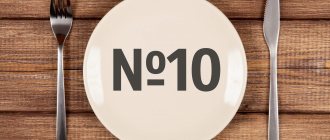Necessity of diet
Diet is the best assistant in treatment. To determine therapy, it is necessary to take a test for Helicobacter; if present, the doctor prescribes treatment with antibacterial drugs. They are always combined with nutritional adjustments. A special diet helps relieve inflammation and accelerates the healing of mucous membranes.
What else does the diet provide:
- relieves attacks of nausea;
- reduces heaviness in the stomach;
- increases the effectiveness of drug treatment.
Following a therapeutic diet also helps solve bowel problems. With gastroduodenitis, diarrhea is often replaced by constipation and vice versa. With a competent approach to nutrition, you can normalize and significantly improve intestinal function.
Diagnosis of gastroduodenitis
Taking anamnesis: carefully question the patient about the time of onset, manifestation, connection of the exacerbation with the time of year and the presence of a similar pathology in relatives.
General blood test, blood biochemistry.
General urine test, urine test for the amount of pepsinogen.
Stool analysis for worm eggs, occult blood and the presence of antibodies to Helicobacter pylori.
Study of gastric juice.
Breath test for the level of Helicobacter urease activity.
Endoscopy with biopsy for histology and determination of the presence of Helicobacter.
Ultrasound of the abdominal organs.
General rules of nutrition on a diet for gastroduodenitis
The effectiveness of any diet depends on the accuracy of following the rules. In addition to the lists of prohibited and permitted products that can be found below, there are a number of general rules. Therapeutic nutrition is based on them.
What is the diet for gastroduodenitis:
- fractionality. You need to eat small portions at least five times a day. You should not make up a lunch of three full courses. One soup or first and second courses in small quantities is enough;
- chopping, chewing. The pieces will irritate the inflamed mucous membranes of the internal organs and cause pain. Therefore, it is important to eat soft or crushed, thoroughly chewed food;
- suitable temperature. During the diet, it is important to eat food approximately equal to body temperature; minor deviations are allowed. There should be no hot or cold dishes in the diet;
- complete exclusion of fried foods. This includes food cooked in a dry frying pan, barbecue, or grill. You can read about heat treatment methods below.
These recommendations are relevant for a diet for gastroduodenitis with high acidity, low acidity, acute and chronic forms.
Authorized Products
During a diet, an important condition remains that the products must be thoroughly crushed.
For this use:
- blenders;
- coffee grinders;
- meat grinders;
- graters
The diet should include as often as possible:
- Fresh juices.
- Compotes.
- Vegetables (finely chopped).
- White bread (preferably dry).
- Galette cookies.
- Low-fat cheese.
- diet sausage.
- Vegetarian soups.
- Lean meat (rabbit, beef, chicken).
- Fruit purees.
- Porridges made from semolina, rice, buckwheat, oatmeal – you can use milk or water when preparing them.
- Dairy products with low fat content.
- Kissels, jelly.
- Cocoa, tea (weak or green).
- Low-fat fish (perch, pike perch).
- Honey
- Marmalade.
- Eggs (steam omelet).
Food should be taken in small portions, chewing well. Small intervals should be taken between meals. The number of meals is 5-6 times a day. It is strictly forbidden to overload the stomach, otherwise even using the necessary products will not produce the desired effect.
In the first days of an exacerbation, the stomach is allowed to rest, drinking only tea and decoctions.
It is recommended to drink up to 2 liters of liquid per day. It will be useful to drink mineral water without gas. They take water in different ways: if the acidity is high, it is better to heat it to 40 degrees; if it is low, they drink it in small sips and slowly, and after 10 minutes they just start eating.
What foods are not allowed on a diet for gastroduodenitis?
The therapeutic diet for acute gastroduodenitis requires strict adherence to all the rules, the exclusion of not only fried foods, but also a number of different foods. Food is prepared at home. It is not advisable to visit cafes, restaurants, and other catering establishments.
What you absolutely cannot do on a diet:
- sausages, smoked meats, any semi-finished products. In addition to meat, they contain a lot of fat, skins, films, tendons and additives that irritate weakened digestive organs and are prohibited on the diet;
- marinades, especially with vinegar and citric acid. All industrial and home preservation, including naturally fermented products, are prohibited for gastroduodenitis;
- all purchased, homemade sauces based on mayonnaise, tomato, hot spices, herbs;
- fresh bread, all baked goods, baked and fried pies, donuts, pancakes are prohibited on the diet;
- raw hard vegetables, fruits. Especially carrots, cabbage, pumpkin. Many types need to be boiled first.
Nutrition on a diet for erosive gastroduodenitis depends on the acidity of the stomach, but requires a mandatory refusal of these products. It also requires careful grinding and taking special medications, which should be selected by the attending physician.
Food features: table No. 5
For this disease, the most commonly recommended therapeutic diet is table 5. In this case, foods that stimulate gastric secretion are excluded from the patient’s diet. Refractory cheeses, fried and spicy foods are prohibited. The menu is based on liquid milk porridges, puree soups, boiled vegetables, fish and meat, eggs, cottage cheese. The consumption of fermented milk products, fruit and berry mousse, jelly and jelly is encouraged. Such a diet will help improve the well-being of the patient with cholecystitis and Gastrodoudenitis, as well as prevent exacerbation of the disease.
Why do you need a diet?
The diet will help not only improve the well-being, but also the health of the patient. A carefully designed and planned diet contributes to:
- preventing exacerbation of the disease;
- preventing the development of related ailments;
- eliminating unpleasant symptoms.
Most often, the necessary diet is prescribed to the patient by a gastroenterologist after a thorough examination and diagnosis. However, you must adhere to a strict diet for a maximum of four months.
What can you eat on a diet for chronic gastroduodenitis?
The diet menu for this disease cannot be called hungry. Large product groups are allowed. If you approach diet planning and cooking with imagination, you won’t have to go hungry. If some products are not available, then they are prohibited or you need to check the possibility of use with your doctor.
Porridges allowed on the diet
While on a diet, you should not eat cereals made from coarse grains with insoluble fiber. You should forget about brown rice, millet, barley. But you can safely eat regular white rice and buckwheat. Liquid porridges made from semolina and ground oatmeal have a positive effect on the functioning of the digestive organs. Occasionally, boiled pasta can be used as a side dish; cheap varieties made from soft wheat are used.
Dairy products allowed for gastroduodenitis
You can include low-fat cottage cheese and a little low-fat cheese in your diet. Cream, sour cream, and baked milk are prohibited. For stomach diseases, it is better to give preference to yogurt, yogurt, kefir up to 2% without additives. During an exacerbation, they are also excluded from the diet.
Eggs are not prohibited on the diet, but they can only be cooked soft-boiled; steamed or baked omelettes are allowed. Fried or hard-boiled eggs are not allowed.
Meat, poultry and fish
Only low-fat varieties are allowed. No lard, lard, bacon, pork, duck, geese are also prohibited. It is not recommended to use offal as food (regardless of the type of animal). Seafood and crab sticks are not allowed.
What you can use:
- lean sea and river fish;
- veal, beef;
- a rabbit;
- chicken, turkey without skin.
Meat and poultry have a lot of coarse fibers, so after cooking they require chopping or minced meat dishes are prepared for the diet. If it is not possible to grind something, then it is allowed to eat pieces with thorough chewing.
Important! Rich fatty and bone broths are prohibited during the diet. But you can cook the soup with a second chicken or fish broth.
Bakery
Yesterday's dried bread and crackers are allowed. With this disease, you cannot have any desserts with cream, but you can have regular dried sponge cake, charlotte with the addition of apples, pumpkin, carrots, and any other fruits.
You can buy biscuits or hard cookies from purchased flour products, but it is important to pay attention to the composition. Some manufacturers are cunning and introduce raising agents and flavoring additives.
Vegetables fruits
A diet for superficial gastroduodenitis does not prohibit the consumption of vegetables and fruits, but it is important to choose non-acidic types. It is also necessary to boil, stew, and chop these products. In their raw form, they contain quite coarse fiber, which is difficult for diseased organs to cope with.
Only bananas, strawberries and soft pears, previously peeled, can be consumed raw.
There are foods that have a positive effect on the mucous membranes - potatoes, pumpkin, zucchini. They can be boiled, pureed, made into purees or creamy soups. Such nutrition is allowed even in the acute stage. With caution and only during favorable periods, you can use boiled onions and a little garlic, only in dishes.
Sweets allowed on the diet
Sugar is not prohibited on this diet, but you should refrain from all types of sweets, store-bought baked goods, and fatty desserts. It is wiser to give preference to jam, jam, jam and other homemade preparations from fruits and berries.
What you can pamper yourself with:
- marmalade;
- marshmallow;
- marshmallows;
- dried fruits.
Honey is also allowed. It can be consumed as a dessert or drink. In folk medicine, a teaspoon is mixed with a glass of warm water and consumed half an hour before each meal. It is believed that this product has a positive effect on the mucous membranes of the stomach.
Fat, oil
Any artificial margarines, spreads, palm oil are prohibited. But you can use vegetable oil and butter. These products can only be added to ready-made dishes, no more than 10 ml per serving. Cannot be used for frying, stewing or baking.
Features of the flow
Gastroduodenitis is a disease characterized by the development of an inflammatory process on the mucous membranes of the stomach and duodenum. The causes of the development of the disease may be poor nutrition, prolonged ingestion of medications, severe stress, etc. Symptoms of gastroduodenitis are typical for many functional disorders of the gastrointestinal tract:
- pain in the epigastric region that occurs 2-3 hours after eating;
- feeling of heaviness;
- nausea, belching;
- indigestion.
Gastroduodenitis is distinguished: according to the form of its course - acute and chronic, according to the stage of development - exacerbation or remission. The same disease sometimes occurs differently in different patients. Gastroduodenitis may be accompanied by increased or decreased acidity, the presence of concomitant gastrointestinal diseases, etc. For a number of apparent reasons, self-medication can aggravate the situation. Treatment in each individual case is individual and prescribed by a doctor. Also, a special menu is developed for the patient, including a certain list of products that do not irritate the mucous membrane.
Diet for intestinal colitis Special attention should be paid to the products themselves included in the menu. Food that is too spicy, hard and difficult to process will lead to irritation of the mucous membrane. The patient is advised to chew each piece thoroughly and not eat on the go.
What can you drink on this diet?
On a diet with any gastroduodenitis, alcohol is immediately prohibited; it negatively affects all organs, not only the digestive system. Also, carbonated drinks and any cocktails with unnatural ingredients, dyes, and preservatives are prohibited. Chemical sparing of the digestive system is carried out.
You can drink jelly; a drink made from oats has a particularly good effect on the functioning of the gastrointestinal tract. Compotes are also allowed, but when choosing berries and fruits you need to take into account the acidity of your stomach. You can also have green or weak black tea. Sometimes the doctor allows cocoa, but not coffee. You can have low-fat dairy products, mainly kefir and yogurt. During the quiet period, fruit juices with slight acidity are allowed.
Causes and symptoms
The following are the main causes and factors that can cause the erosive form of gastroduodenitis in humans:
- Increased acidity in the intestines, in which there is insufficient formation of protective mucus in the intestinal cavity.
- Serious hormonal disorders in the body, which negatively affect the functioning of the digestive system.
- An important role is played by the negative impact of chronic diseases of the liver, gall bladder, and the entire endocrine system.
- All kinds of frequent stress, nervous strain and psychological pressure.
- A monotonous diet, in which the body does not receive even half of the nutrients it needs. This in turn leads to disruption of the general functions of the digestive system.
- Damage to the digestive tract by the dangerous pathogenic bacterium Helicobacter.
- Long-term treatment with aggressive, potent medications that irritate the walls of the stomach and intestines.
- Eating spicy, fatty or hot foods.
- Negative effects of various chemicals.
- Genetic predisposition to the disease or infection.
Erosive gastroduodenitis may be accompanied by the following symptoms:
- Intolerance to certain foods.
- Feeling hungry just an hour after eating.
- Pain of different localization and nature.
- Bloating, nausea and vomiting, especially during exacerbation of the disease.
- Indigestion.
- Pallor.
- Blood in stool.
- Abnormal stool.
- General deterioration of health with superficial gastroduodenitis.
- Weakness.
How to treat erosive gastritis - read in this article.
Cooking food
The diet involves using only gentle cooking methods. Approximately 80% of foods need to be boiled (steamed, in water). About 20% can be left for baking and stewing. When cooking soup, a second broth is used. That is, after 5 minutes of boiling meat or poultry, the first water must be drained.
What else do you need to know:
- You can add salt, but in small quantities;
- It is better to add fats to the finished dish when serving;
- You shouldn’t bake food to a strong crust; it’s better to cover the pan;
- Baking is prepared a day before use.
Molds with modern coatings, baking paper, bags, and foil will be good helpers. A blender is a must. A double boiler will not be superfluous.
Menu for a week for a diet for gastroduodenitis in the acute stage
The strictest diet is observed for gastroduodenitis in the acute stage. At this stage, maximum sparing of the digestive organs is important. Absolutely all dishes must be pureed and chopped. You can prepare them in the usual way, then beat them with a blender. If your diet includes porridge, then give preference to liquid and viscous consistencies.
| Monday | Tuesday | Wednesday | Thursday | Friday | Saturday | Sunday | |
| Breakfast | Oatmeal jelly, a piece of yesterday's biscuit | Liquid semolina porridge with milk | Viscous oatmeal, a piece of biscuit | Ground rice porridge | Steam omelette with milk, tea | Pear jelly with starch, hard biscuits | Rice porridge with milk and butter |
| Lunch | Steamed apple puree | Banana puree | Pumpkin puree | Baked apple | Cottage cheese casserole | Banana | Baked zucchini |
| Dinner | Pumpkin cream soup, croutons | Potato soup with rice, stale bread | Creamy chicken and potato soup, homemade croutons | Puree vegetable soup, croutons | Milk soup with noodles, butter | Rice soup with beef, yesterday's bread | Fish soup with vegetables, stale bread |
| Afternoon snack | A glass of kefir, fermented baked milk or white yogurt. You can eat a portion of low-fat cottage cheese for an afternoon snack. | ||||||
| Dinner | Mashed potatoes, twisted boiled beef | Steamed cauliflower, piece of fish | Soft-boiled egg, vegetable puree | Steamed fish cutlets, boiled buckwheat | Fish casserole with rice | Stewed zucchini with chicken | Vegetable stew with veal |
Recipes from the menu for a week of diet for gastroduodenitis
So that the therapeutic diet for acute gastroduodenitis does not become a burden, we recommend sticking to a varied menu. There is no need to eat only porridge for breakfast, lunch and dinner. Meat dishes, soups, and casseroles will help diversify your diet. They are prepared taking into account all the requirements of a therapeutic diet. Here are some of the most interesting recipes from the menu above.
Fish casserole with rice
For this casserole, you can use minced fish from any fish. It’s better to cook it yourself; store-bought minced meat contains a lot of unnecessary additives.
Ingredients:
- 500 g fish fillet;
- 1 carrot;
- 150 g boiled rice;
- 1 egg;
- 4 spoons of kefir;
- salt.
Preparation:
- Simply boil the rice in water and remove excess liquid.
- Grind the carrots and fish through a meat grinder, add the egg, rice, add salt and stir thoroughly.
- Transfer the mixture into the mold and smooth it out. Pour kefir on top and distribute evenly.
- Place the casserole in the oven. At 180 degrees it will cook for about half an hour.
This dish can be prepared not only with rice, but also with boiled buckwheat, or add boiled vegetables instead of cereal.
Creamy soup with chicken and potatoes
You can puree any regular soup, but it is better to specially prepare a creamy dish. Awesome recipe for lunch or dinner.
Ingredients:
- 5 potatoes;
- 200 g chicken;
- 1 carrot;
- salt.
Preparation:
- Boil the chicken in a liter of water, remove the bones and return the meat.
- Add chopped potatoes, carrots, cook vegetables until soft.
- Puree the soup until smooth in a blender. Add a little milk if desired. Taste, add salt and bring to a boil.
Soups from zucchini, pumpkin, and other vegetables are prepared in the same way. Delicious dishes come from assorted dishes.
Recipes
Who said that food for duodenitis and pancreatitis should be boiled to a semi-liquid state, pureed and completely tasteless? This is the deepest misconception! We offer you several food recipes, after tasting which you will forever change your opinion about dietary nutrition.
First meal
Pumpkin soup
To prepare this nutritious and incredibly tasty soup you will need:
- 750 grams of pumpkin pulp;
- 250 ml water;
- 500 ml skim milk;
- A piece of butter.
Wash a small pumpkin thoroughly, peel and cut into cubes.
Pour the prepared pulp with cold water, bring to a boil and simmer over low heat until it becomes soft.
When the pumpkin is ready, puree it using a blender or strain through a metal mesh sieve.
Pour milk into the pumpkin puree, stir and keep at a low simmer for another 10-15 minutes.
Add salt to taste, add butter and, if there is no aggravation, just a little black pepper.
The soup will be thick, creamy, and a pleasant yellow color.
Flour soup
To prepare this simple but delicious soup, take:
- 1 liter of chicken broth;
- 50 grams of wheat flour;
- A piece of butter or a tablespoon of good sour cream.
Let's cook chicken broth. When it is ready, take out the meat (you can prepare a second dish from it), and strain the liquid, leaving about half a glass to cool, and bringing the rest to a boil again.
While the broth is boiling, fry the flour in a dry frying pan. It should take on a golden hue.
We dilute the flour with chilled broth, pour it into a saucepan with boiling liquid, stir very well (if this is not done, lumps can quickly form - then you won’t break them!) And cook over low heat, stirring, for 15-20 minutes.
Add some salt, throw in just a couple of grains of pepper and pour into a plate. Season with sour cream or butter.
Bread soup
In the bins of dieters there will definitely be pieces of stale bread, which is no longer bearable to eat, but fresh bread is still harmful. From such an unattractive product you can prepare a hearty stew.
So, collect the stale pieces lying around in the bread bin, fill with cold water and place on the stove. As soon as the liquid boils, reduce the heat. Let it simmer slowly for about an hour.
Currently reading: Erosive duodenitis
Then grind the bread mixture until smooth, add milk or cream, bring to a boil, add salt and pepper - just don’t overdo it! The proportions of this dish are not easy to determine: it all depends on the staleness of the bread and the fat content of the milk. However, you yourself will determine the optimal amount of both to make the stew tasty and not too liquid.
Second courses
Potatoes boiled in milk
Few people know about this unusual method of preparing potatoes. Meanwhile, this is a very tasty, nutritious and healthy dish.
Take:
- 250 grams of potatoes – thoroughly washed, peeled and cut into cubes;
- 100 ml milk;
- A little butter;
- Finely chopped dill and parsley.
Place the prepared potatoes in boiling salted water and boil for about 10 minutes, then drain the water.
Pour boiling milk over the potatoes and cook at a very low simmer until fully cooked.
Place the finished dish on a plate, pour over melted butter and sprinkle with finely chopped dill and parsley.
Meatballs in chicken broth
To prepare this delicious dish, take:
- 125 grams each of chicken fillet and beef;
- 100 grams of boiled rice;
- Egg;
- A small onion;
- Bell pepper or two leaves of white cabbage;
- Chicken bouillon;
- Bay leaf;
- Salt and pepper to taste.
First of all, prepare a container for stewing (for example, a thick-walled pan): place cabbage leaves or green bell pepper cut into strips on the bottom, finely chopped onion and bay leaf on top.
Pass completely thawed and thoroughly washed meat through a meat grinder. Mix it with chilled rice and egg, salt and pepper.
Form the minced meat into walnut-sized balls and place them tightly on top of the chopped vegetables in several rows.
Carefully pour in the cold chicken broth around the edge. Take it with a reserve: meatballs absorb a lot of liquid, not only during cooking, but also when cooling.
Bring to a boil and simmer until tender over low heat (an hour and a half).
Before finishing cooking, taste the broth for salt. Add more if needed.
These meatballs are very tasty with mashed potatoes.
By the way, instead of broth you can take a mixture of water and tomato juice, it will turn out no worse. This delicate dietary dish will surely become a favorite not only among you, but also among all your family!
Lapshevnik
Admit it, are you tired of endless steamed omelettes and milk soups with noodles? On their own, it’s possible. What if you try to combine the ingredients of these dishes? The result is a delicious casserole!
First, cook a fairly thick milk soup with any pasta. Some people like small noodles, others like finger-thick horns, it’s a matter of taste.
Mix 3-4 eggs using a whisk. There is no need to be too zealous, they should turn into a homogeneous mass, that’s all.
Pour the egg mixture into the pasta, stir, transfer to a mold and place in an oven preheated to 180°.
Check the readiness of the food with a thin wooden stick: there should be no traces of liquid on it.
Place the finished casserole on a dish, cut into pieces, sweeten slightly... And you can try it if they leave at least a piece for you.
Sweet dishes
Fragrant fruit and melon compote
To prepare this refreshing compote, you will need:
- 1 liter of water;
- 1-1.5 cups sugar;
- 200 grams of ripe plums and apples;
- 100 grams of juicy (not too sweet) pears;
- 250 grams of melon.
Dissolve sugar in water and bring the liquid to a boil.
Dip plum halves and sliced apples and pears (without peels or cores) into the syrup.
Boil until the fruit is ready.
After removing from the stove, add the peeled and diced melon to the compote.
Sour cream and strawberry jelly
To prepare this dessert you will need:
- 0.5 liters of low-fat kefir;
- 250 grams of sour cream;
- 150 grams of sugar;
- Strawberry juice and a few whole berries for decoration;
- 1 teaspoon gelatin.
Using a whisk, mix kefir and sour cream well.
Add sugar and lightly beat the resulting mixture.
Divide it into two parts. Add two to three tablespoons of strawberry juice to one.
Dissolve gelatin in 150 ml of water. Add it with a tablespoon to either the white or pink mixture, so that there is an equal amount in each.
Pour the pink mixture into the bowls and place in the refrigerator for 10-15 minutes until it hardens slightly.
Spread white evenly over the pink layer, decorating each bowl with a whole berry.
Place in the refrigerator for 2 hours.
Coffee cream
Everyone knows that a bad stomach and coffee are incompatible concepts. But not as part of dessert! There is very little of it here, just for taste and aroma.
Take:
- Three fresh chicken yolks;
- 125 ml strong coffee;
- 100 grams of sugar;
- 500 ml cream;
- 1 tablespoon gelatin;
- A packet of vanilla sugar.
Currently reading: Catarrhal duodenitis
Mash the sugar and yolks with a wooden spoon.
Pour hot coffee into the mixture, stir thoroughly and cook in a water bath until the mixture reaches the consistency of liquid sour cream.
Remove the mixture from the heat and cool.
Add vanilla sugar and gelatin diluted in a small amount of water.
Separately, whip the cream and very carefully, using top-down movements, mix it with the cooled mass.
Moisten the bowls with cold water, spread the finished cream and place in the refrigerator for 2 hours.
